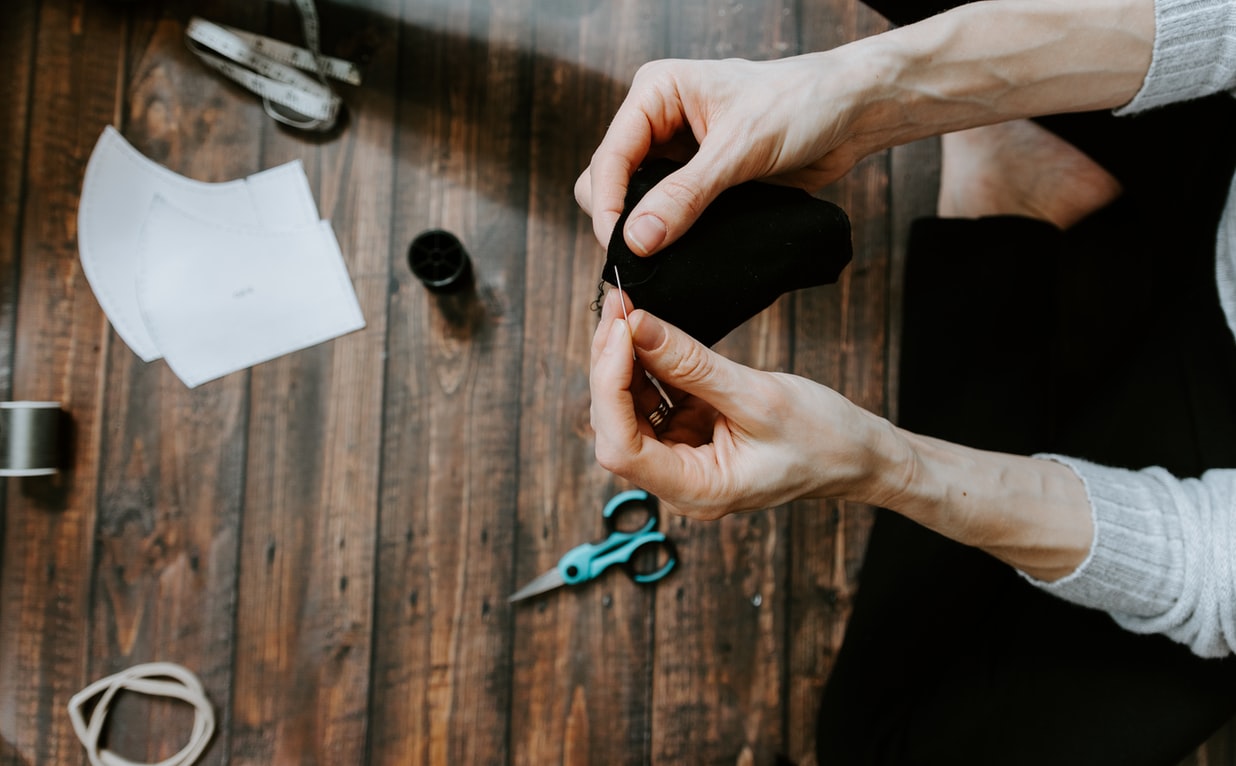News
Getting to Know Proudly Indigenous Artists
Getting to Know Proudly Indigenous Artists
Whether it’s through vibrant beaded earrings, seal skin mitts or tufted purses, Indigenous artists are combining traditional fashion with contemporary styles to create one-of-a-kind pieces. Proudly Indigenous Crafts and Designs showcases a number of designers whose work will make anyone stand out in a crowd, while causing looks of admiration. The artists come from across Canada, ranging fromTukoyaktuk, NT to Labrador City. Here, we get to know some of the people behind the work and what inspires them to keep creating.
Erica Lugt—She Was a Free Spirit
View this post on Instagram
In 2017, Erica Lugt took a cardholder-making course in Inuvik. With each stitch and colourful bead gracing the material, Lugt knew she wanted to keep creating. It didn’t take long for her to launch her online business, She Was a Free Spirit, where she uses her knack for colour coordination to make vibrant earrings. As a mother with a full-time job, Lugt finds any spare moment she can to create more pieces. Her jewelry is inspired by the land and her Inuvialuit culture—particularly Inuvialuit dancing parkas. “I’ve always been attracted to color. I bring my love of color, of all colors and what my eyes interpret from the colors of the Arctic to my creations,” she says. Aside from finding Lugt’s items online, her work has been featured at Indigenous Fashion Week Toronto in 2019 and 2021, at the 2021 Earring show with BC Craft Council and through the EntrepreNorth Fashion Cohort.
Inuk — Inuk 360
View this post on Instagram
Inuk, an Inuvialuit designer, grew up around moose hair tufting, a traditional craft from the Fort Providence NT area, but it was a high school teacher who inspired her to start doing it herself. Her artistic journey began in 1990, when she taught herself the skill of tufting, at a time when the craft was dying out. Inuk helped revive the craft and has since taught it to thousands of people across the world. Under her line Inuk360, Inuk has created seal fur cuffs, earrings and even “inukyfied” heels with dyed seal fur. Known as the “Master Tufter,” Inuk is inspired most by everything that has happened in life, she says.
“Some of my greatest creations have come from the darkest times of my life. Creating art is kind of like therapy for me… For example, I created my beaded bliss, seal skin, and traditionally tanned moose hide cuffs in honor of some strong women who had passed away and had a lasting and positive impact on who I am becoming.”
Inuk has donated some of her work to several online auctions, to help raise money for Missing and Murdered Indigenous Women as well as to an Indigenous language camp. She has also donated 100 percent of the money sales she received in 2021 from a seal fur pendant she had made titled “Haylee’s Heart.”
Cheryl Fennell —Snowfly
View this post on Instagram
Since 2014, Cheryl Fennell’s Indigenous inspired designs, including jewelry, clothing, furniture and tapestries, have become widely known.
Fennell’s first pieces became sought after, following singer Tanya Tagaq’s appearance at the Polaris Music Awards, where she donned Fennell’s seal skin cuffs.
The Yellowknife Metis designer’s love for traditional style began long before at the age of six, thanks to her Dene mother. Just two years later, however, Fennell lost her parents and was taken from the NWT and away from her culture.
Fennell eventually returned and moved to the Arctic, where Inuit friends taught her how to see and create a design “from within rather than applying someone else’s dreams,” she explains.
Fennell uses seal skin because of its vibrancy and because it represents her time spent with Inuit who helped her return to her traditional roots. While she previously worked in the policy analysis field, Fennell has always been inspired by creativity and design and plans to continue creating pieces based on her tradition.
Taalrumiq — Taalrumiq
View this post on Instagram
Inspired by her mother, grandmothers and women in her home community of Tuktuuyaqtuuq, Taalrumiq Christina King’s vision is deeply impacted by her love for Inuvialuit culture, the Arctic Ocean and the Tutktuuyaqtuuq landscape. Her skills have been passed on to her through generations before studying fashion design at the University of Alberta, while minoring in art. That level of knowledge is obvious in her work.
“Each piece I make is created with the utmost care, quality and attention to detail as if I was sewing for my own family,” she says. “I love the materials, process and story behind each piece and the opportunity to share Inuvialuit culture with others.”
Much of Taalrumiq’s fashion designs involve working with traditional Inuvialuit design elements and organic materials like sealskin, fur, hides, feathers and antler. She combines that with modern materials like sequins, glitter and metallic leather. Some of her work features colourful designs into seal and leather mitts, while others feature vibrant colours and detailed beading.
Because of her items, such as mitts, masks, pins and jewelry, Taalrumiq was named one of Canada’s top 10 Inuit Sealskin Designers to Watch in 2021 by Inuit Art Quarterly. Taalrumiq is set to attend the Banff Centre for Arts and Creativity’s Indigenous Haute Couture Residency this spring. She is one of 10 artists chosen from across Canada. Plus, she was selected as a Marketplace Vendor to sell her original Taalrumiq pieces at Indigenous Fashion Arts in Toronto this summer.
Bambi Amos—Bambi’s Traditional Arts
View this post on Instagram
When Bambi Amos finished her first project in Sachs Harbour—a pair of sheared beaver mitts—she remembers feeling amazing. “It was just such a sense of accomplishment,” she says.
Now, Amos is selling her beautifully crafted mitts online through the name Bambi’s Traditional Arts. Inspired by her Inuvialuit culture, Amos primarily uses seal skin, as well as fox, beaver, and rabbit fur to ensure the wearer will stay cozy all winter long. Amos manages to sew outside her full-time job and ensures each pair is made with the utmost detail. That time and attention is part of what makes each piece so special.
“I take the time to do a really good job,” she says. “I strive to do really good work.”
As her business starts to take off, Amos says it’s important to pass the message along to other aspiring artists to let them know that they should keep going, no matter what. “Just follow your dreams. Do what makes you happy.”
April Allen—Stitched by April
When April Allen had to retire from her career as a dental therapist in 2012 because she developed multiple chemical sensitivity, she was at a loss.
“I was kind of forced to retire out of that field,” she says. “That actually took a huge toll on me.”
Not knowing what to do, Allen returned to something her mother had taught her as a child: beading and sewing. The Rigolet, Nunatsiavut-born woman began creating earrings, bracelets, slippers and other items under her line Stitched by April. Her pieces combine traditional and contemporary designs.
“My signature earrings are made with sealskin and fox fur,” she explains, adding that she has a V shape incorporated into the design. “It resembles a traditional tattoo located on the forehead [of many Inuit women], which signifies entering womanhood for us… it’s a special part of my culture. For so long Inuit were ‘not allowed’ to have tattoos. This is my way of sharing a part of our culture that we are reviving/reclaiming. To me-The V shape design represents strength, resilience, connection to my culture, and our history.”
In addition, April uses antler and salmon skin leather for some of her other pieces.
When Allen sees people wearing her designs, she says it’s a rewarding feeling. Most of her pieces come with a pamphlet explaining more of the meaning behind the product and delves a bit into Allen’s culture. It’s a chance to share her background with others and to raise awareness about the use of traditional materials.
The artist, who currently resides in Labrador City, also recently launched an online bead supply shop called Indigenous Bead Supply Canada.
Bibliography
-
-
- https://proudlyindigenouscrafts.com/artist/she-was-a-free-spirit/
- https://proudlyindigenouscrafts.com/artist/cheryl-fennell/
- https://proudlyindigenouscrafts.com/artist/bambi-amos/
- https://proudlyindigenouscrafts.com/artist/aprilallen/
-


 Français
Français 简体中文
简体中文 ᐃᓄᒃᑎᑐᑦ
ᐃᓄᒃᑎᑐᑦ